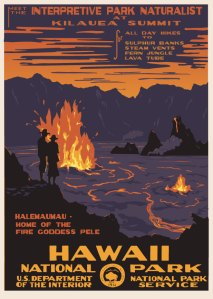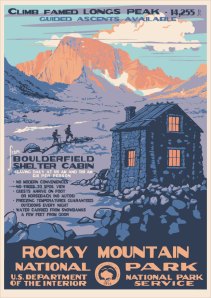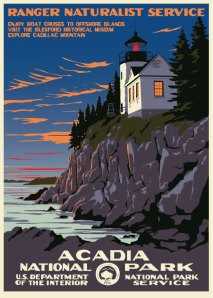 Speaking of finding stuff in attics and digging up hoards of Anglo-Saxon treasure, Volunteer Park Ranger Doug Leen (day job, dentist) has worked for decades to track down vintage posters of U.S. National Parks and to recreate them. Here’s how he got started:
Speaking of finding stuff in attics and digging up hoards of Anglo-Saxon treasure, Volunteer Park Ranger Doug Leen (day job, dentist) has worked for decades to track down vintage posters of U.S. National Parks and to recreate them. Here’s how he got started:
During the fall of 1972 or 1973 in the Tetons, which was my second or third season there. Every year we’d have a cleanup day and every ranger would work on cleaning up after the summer season. My boss called and we commenced to clear out the old horse stalls at Beaver Creek, which were full of stuff laced with cobwebs.
We were working in the barn when I noticed an old poster destined for the burn pile. It was hanging by a nail up on a crossbeam. I thought it was unique and asked my boss if I could have it for my Jenny Lake park cabin; it later ended up in my house in Seattle when I began studying dentistry. At the time of its “discovery,” there was no huge artistic attraction as only 30 years had elapsed since its publication at the Western Museum Laboratories in Berkeley, California.
 With that find, an obsession was born. You really should check out the hoard of artistic treasures he’s rediscovered and recreated. (Here’s a tip: try opening this link in Firefox–when I used IE, I couldn’t see the images on the first page.) Many thanks to Historiann’s blog administrator, DMM, who sent me these stories–and who’s spent some good times with Famille Historiann up in our local national park, Rocky Mountain N.P. (By the way, the Boulderfield Shelter Cabin–not an option any longer when you’re climbing Long’s Peak, friends. That sure looks a lot more cheerful than a lonely tent on the mountainside!)
With that find, an obsession was born. You really should check out the hoard of artistic treasures he’s rediscovered and recreated. (Here’s a tip: try opening this link in Firefox–when I used IE, I couldn’t see the images on the first page.) Many thanks to Historiann’s blog administrator, DMM, who sent me these stories–and who’s spent some good times with Famille Historiann up in our local national park, Rocky Mountain N.P. (By the way, the Boulderfield Shelter Cabin–not an option any longer when you’re climbing Long’s Peak, friends. That sure looks a lot more cheerful than a lonely tent on the mountainside!)
Some of you may have heard that Ken Burns’s new 6-part, 12-hour film, The National Parks: America’s Best Idea, premiers tonight on PBS. It sounds like more of the old Ken Burns schtick–well-written, informative, and beautifully photographed, but unbearably celebratory and sentimental. His thesis in every movie is: “(Insert Topic Here) is a genius that made America America!” So, Frank Lloyd Wright–he was a genius! Thomas Jefferson–another genius! I’m sure we’ll learn tonight that the National Parks were. . . well, “America’s Best Idea!”
 Ken Burns makes Americans feel good about America, and that’s what the people want. Plus, PBS can re-run the series endlessly during pledge week. (Why don’t professional historians write books people actually want to read? Why do we hate America, anyway?)
Ken Burns makes Americans feel good about America, and that’s what the people want. Plus, PBS can re-run the series endlessly during pledge week. (Why don’t professional historians write books people actually want to read? Why do we hate America, anyway?)
Wow, that artwork is beautiful. I’d like to decorate my own house with such posters! There were some truly amazing works produced by the WPA, and the National Park posters seem to be perfect examples.
Maybe historians other than Burns would be more beloved if you’d stop digging up all those embarrassing foibles that everybody wants to forget 😉 “The history of America’s love of cute fuzzy animals” would be a guaranteed best-seller… (until you realize it’s all about how the early pioneers ATE adorable widdle bunny wabbits!)
There is some room to critique the National Park system — trying to strike a balance between leaving the land and ecosystem untouched, while creating an infrastructure to allow thousands of people to visit and enjoy the landscape, is difficult. On the whole, though, I prefer a society which endorses the NPS; preserving extremely pretty parts of the landscape is a good gateway introduction into conservation, sustainability, and environmentalism.
LikeLike
I like one particular point from the Rocky Mountain National Park poster, “Freezing temperatures guaranteed outdoors every night!” — Not usually a selling point you see on a travel brochure! 😀
LikeLike
As to your final question: I’m a medievalist, so my boring books mean I hate western Europe. It’s a big job.
LikeLike
Notorious: I think you hate all of Western Civilization. I think you’d better cop to that, now, so that the right can hate you as much as they hate me, hatin’ on America.
Erica: you know what they say out here? In the Rockies, June is spring, July is summer, August is autumn, and the rest of the year is…(Srsly, we are always tramping across snow fields in June!)
LikeLike
If anyone has a student/s and wants to commission a cool piece of feminist Park Service history they could head up to Grand Canyon Village, where there’s an old NPS “company town” cemetery among the trees. It includes (it’s some years ago and the specific details are hazy) headstones of “Harvey Girls,” young women who worked in the Harvey railroad hotels that dotted the National Park landscape of the west. They are interspersed in an interestingly democratic (for the time, anyway)fashion with headstones for former park superintendents and deputy superintendents. When I first saw them I thought there has to be some interesting history buried here.
It’s sort of amazing that this many years after George
Robert Twelves Hewes, Martha Ballard–and to say nothing of her “girls”–there are historians surprised at the idea of books about “previously unknown people.” I was at a conference yesterday where we heard short sketches of the interesting afterlives of survivors of partial scalpings, of minor functionaries of the South Sea Company in the circum-caribbean world, and others. I think that’s where at least half the fun is in this business these days. And it could, and has, crack into some part of the Burns demographic without having to erase the foibles.
LikeLike
p.s. a quick, “after the send” google indicates that there is a c. 1994 book on the history of the Harvey Girls, as well as a “Harvey Girl Historical Society,” somewhere out there–but whether in the celebratory, sentimental, or srsly genre modes, it’s not clear.
LikeLike
I recently had a class of sixth-graders insisting that cold completely killed plants. I asked, “What about pine trees in snow on top of mountains?” They all looked dubious — considering the South Carolina midlands has neither snow nor mountains, I can’t entirely blame them!
LikeLike
The other thing about the Ken Burns NP extravaganza (eagerly awaited here at the gateway to Yosemite) is that it is a world of consensus, with no debates about interpretation.
LikeLike
Susan, you are at the gateway to Yosemite? I have people down that way, in Amador and Calaveras counties.
This is the only Ken Burns documentary I’ve ever wanted to see—and I’m kinda fine with a wholly celebratory look at the National Park system and making Americans feel good about it. Two summers back, driving into Arches NP, my sister and I broke into spontaneous song “This Land Is Your Land” (oddly, we were practically the only US tourists—tons of Europeans, etc, doing the parks in that region).
Incidentally, in Time’s 10 questions with Ken Burns this week (okay, the media barrage *is* starting to get to me, when I’m not being fascinated that the NPS has enough pull to make it happen), KB specifically indicted the “previous Administration” for neglect. Anyhow, support for the NPS is a much preferable channel for Americans to feel good about America than thinking Jefferson could do no wrong.
LikeLike
And, these are awesome posters and I’m checking out the link.
LikeLike
Dance, a little south and west, but that’s what we call ourselves. Mind, I suspect there are several places in the valley that think of themselves that way 😉
LikeLike
But don’t you know that America is the greatest country EVER!
I must admit that I planning on tuning into the Ken Burns’ extravaganza tonight. I don’t know how much attention I’ll pay to the whole thing—coincidently, I have to finish revising my paper about Mesa Verde National Park, but my partner wants to watch it (I think he actually wants an opportunity to mock Ken Burns). And I am curious to see how much gender/women’s history is included since women founded several of our national parks.
Anyway, I hear the documentary is called “Ken Burn’s The National Parks: America’s Best Idea” or some such nonsense. The title sort of makes me want to see “Ken Burn’s [insert opinion]: America’s Worst Idea” or something. Maybe next year? Or is that a task for the drunk historians on You Tube?
LikeLike
I didn’t see the Burns documentary last night–I was watching something else, but clicked over to PBS a few times. As I suspected–lots of sentimentalism and impressive scenery, and Peter Coyote’s reedy, avuncularism as the narrator. But–as Susan suggested above, there’s no conflict, there’s no drama, no narrative tension.
Oh, and the National Parks? Genius!!!
LikeLike
Just to prove my general hatred of America, the National Parks openly discriminated against African Americans for decades. For a great discussion of this discrimination check out Susan Session Rugh, _Are We There Yet? The Golden Age of American Family Vacations_. Wilderness was/is constructed as a “white” space. Segregation, America’s best idea?
LikeLike
Whatwhatwhat, widgeon? Discrimination in access to America’s Best Idea? Next thing I know, you’re going to tell me that African Americans were also not permitted access to America’s Second-Best Idea, the U.S. Constitution and the rights it guarantees?
Your hatred really knows no bounds, does it?
LikeLike
The construction of wilderness as “white space” is a really important theme which, of course, Ken Burns’ documentary didn’t cover. Not only did the NPS discriminate against African Americans, but the establishment of Yellowstone made it illegal for Native Americans and poor whites to hunt, gather firewood, and pick berries—all activities that they had relied on for survival. Instead, Burns’ documentary stated that National Parks were America’s greatest ideas because they were democratic and made land available to all.
Also, I would just like to point out that in two hours, I believe there was only one woman mentioned despite the fact women were active conservationists. It will be interesting to see if women are mentioned in Burns’ discussion of Rocky and Mesa Verde.
LikeLike
Mary–there are 10 more hours to go of Burns’s series, right? But I tend to agree with the thrust of your post, which is that if the racist assumptions and policies that shaped the founding of that national parks are totally absent in the first 2 hours, I wouldn’t hold my breath that they’re going to take center stage at any point in the next 10. But, I hope you can watch more and report back for us on this.
Interestingly, Burns has of course made documentaries in which race was central (the baseball and jazz documentaries, for example), and he even did one brief film about Elizabeth Cady Stanton and Susan B. Anthony and the women’s suffrage movement. But these movies too suffer from the same Burns treatment: as with his other biographical movies, he posited Anthony and Stanton as “geniuses” without whom American feminism never would have happened, and in the Baseball movie, he makes the integration of major leagues a kind of transformative moment that solves all problems and erases all injustice. So, once again history happens only because of the occasional “genius” who shows up to change everything totally and completely and without whom this change never would have happened, and massive, complex histories of injustice and exploitation are atoned for in one great moment of heroic vision (integration of MLB) or sacrifice (the Civil War.)
Awesome!
LikeLike
Historiann,
Yes, there’s another ten hours. Five more episodes which play all week. I hope to catch at least the next two. The preview for tonight’s episode really highlighted Roosevelt’s role, so like you, I’m not super optimistic that Burns includes a lot of information on women, but he certainly can’t ignore them at some parks. I guess I’m more interested to see how he portrays them women he does include. I have a feeling that he’ll revert back to the whole genius theme, but we’ll see.
I’ll keep you updated.
LikeLike
Thanks, Mary! Happy viewing.
LikeLike
Well, let’s see. Episode two continued to ignore class struggle in the parks. Instead, it maintained that parks were established to reflect American egalitarianism.
The episode once addressed the difficulty rangers faced in telling longtime residents of Yosemite Valley they could no longer subsist off the park’s lands. However, any mention of class was overshadowed by a quick reference to race—the park ranger mentioned that black rangers faced especial difficulty in getting poor white men and women to follow the park’s new rules.
Gender was absolutely ignored in the discussion about Mesa Verde. Instead, Virginia McClurg was portrayed as greedy for wanting to keep Mesa Verde under the control of clubwomen. One of the commenter’s stated that McClurg had come to see Mesa Verde as her park instead of America’s park. God forbid that a woman who spent 20 years of her life preserving a site might actually want (or deserve) to have some say in how the federal government would run it. All patriotic American women are self-sacrificing you know.
As predicted, most of the time was spent discussing conservation’s geniuses—Muir, Roosevelt and Pinchot. So all and all, I would say this episode was more disappointing than the first but this may because I’ve spent the last year and a half critiquing some of the arguments it made. I may or may not tune in tomorrow.
LikeLike
Mary–well, that’s disappointing, but predictable. (In fact, we predicted it!)
You can’t think that Burns would let McClurg look heroic for getting in the way of “America’s Best Idea!” She and her old biddies should just have handed the park and all their work over without a struggle, like good girls, and kept her mouth shut. That’s the American way!
LikeLike
Mary, what’s your opinion on the use of the black park ranger to voice many of these “democratic parks!” sentiments? I am pondering that.
LikeLike
Dance,
I’ve been thinking about that too. Ultimately, I think Burns makes a conscious effort to include non-white individuals (and women) as commentators so that he can create a documentary about mostly white men without being critiqued for having made a documentary about mostly white men.
In the case of the black ranger, I think it is one way in which Burns can buttress his argument (Democratic Parks!) without addressing how certain parks have represented of white, middle class values.
However, I also feel like the black park ranger is getting a raw deal. I mean, we don’t get to see his whole interview. So we don’t know how his views might have changed while working for the NPS or if he believes NPS policies were once racist. We also don’t know what questions that were asked, but it seems unlikely that Burns asked him how his identity as a black male has impacted his job.
LikeLike
Thanks, Mary. I’ve only had it on in the background (and last night was switching between it and So You Think You Can Dance), but I’m feeling like there is also a conscious effort to interject the historical voices of Native Americans as voiced quotations, but I’ve not yet seen a present-day Native American talking head (unless it’s one of the writers/historians and I’m not knowledgeable enough to recognize a name, which is entirely likely, not my field).
LikeLike
Interesting discussion; I think one of the commentators is Native American, but I’m not sure.
LikeLike
Dance and Bardiac,
I also think that one of the commentators is Native American. I also forget his name but I think that he is a Park Superintendent somewhere.
And I thought last night’s episode did an OK job of discussing the commodification of Indian culture. It also mentioned how some parks made it illegal for Indians to hunt and fish on their Native Lands.
LikeLike
Pingback: What We’re Reading: October 1, 2009 Edition - American Historical Association